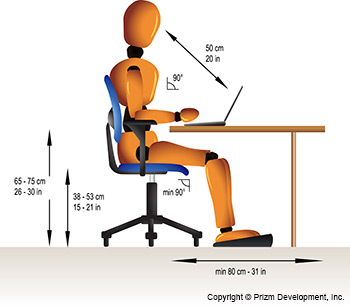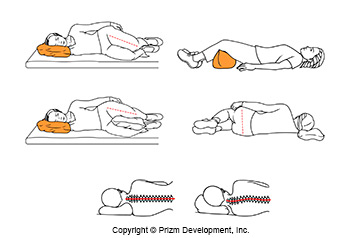Preventing Back Pain
![]() Once you encounter back or neck pain, you are four times
as likely to experience it again. This is why prevention is essential
to your long-term recovery.
Once you encounter back or neck pain, you are four times
as likely to experience it again. This is why prevention is essential
to your long-term recovery.
One of the best ways to avoid back pain is by exercising and stretching. Low-impact aerobics, such as walking or swimming, are an ideal way to prevent or treat back pain. Stop if the exercise becomes painful, and always remember to stretch. Stretching is easy to incorporate into your daily routine. You can even do it in front of the television.
Below are some more specific ways to prevent back or neck injuries:

Sitting for long periods
The spine likes movement. Anything that puts the spine in a static position creates stress, which can cause back and neck pain. Every hour, stand, walk around, bend, arch backward gently and twist. Doing so at regular intervals will lengthen the amount of time you can sit comfortably. Also, get an ergonomically designed chair or an orthopedic insert to support your spine, especially if your job involves long periods of sitting. Or roll up a towel and place it behind your low back.
A comfortable way to stand
Prolonged standing can also strain the back. If you have to stand for long periods of time, prop one foot on a small stool or telephone book to reduce stress in the low back. Alternate with the other foot. Every half hour, bend over and touch your toes with your knees slightly bent or do some of the stretching exercises shown on this website. They will help loosen your muscles, ligaments and joints.
Plane rides
While traveling on a plane, it helps to raise your feet on a briefcase or a bag underneath the seat in front of you. Ask for a pillow to place behind your low back to improve lumbar support. It is important to get up frequently and walk to the bathroom and back whenever possible. Avoid hour-long periods in your seat.
 The best sleeping position
The best sleeping position
Avoid sleeping on your stomach, which arches your back and puts pressure on your spine. Instead, lie on your back with a small pillow tucked under your knees. This position unloads the spine. An alternate position is to lie on your side with a pillow between your knees. If you like sleeping on your stomach, place a soft, flat pillow under your stomach to eliminate some of the arch that can stress your back.
Mattress considerations
It is important to sleep on a mattress with optimal back support, whether it is a conventional mattress or a waterbed. Older waterbeds were mushy and provided little support. However, now there are waterbeds that allow you to adjust their firmness. A good mattress should relate to your body shape. Generally, go with what feels comfortable to you.
When buying a new car
- Automatic transmission (reduces the use of foot pedals)
- Power steering (reduces the amount of effort to steer and turn the car)
- Car seat design – look for good lumbar support and a firm seat
Domestic chores
Avoid transporting heavy or large objects from one place to another after your surgery (eg. leaving ironing board in a suitable place rather than taking it in and out of a cupboard, arrange to have someone take out the rubbish). Also, try to avoid heavy physical tasks (e.g. washing the car), particularly jobs that involve twisting and bending.
Relax
Relaxation is a useful tool for people with back pain (or anyone in general) for several reasons:
- It can prevent or alleviate aches and pains caused by excessive muscle tension.
- It can help minimize unnecessary fatigue and is useful in aiding recovery after strenuous exercise.
- It can raise the threshold for tolerance to pain.
The main aim of relaxation is to achieve a complete state of physical rest. Although this sounds easy, it is not something that comes naturally to us and must be learned and practiced. Talk to your medical team for more information.
[Top]
